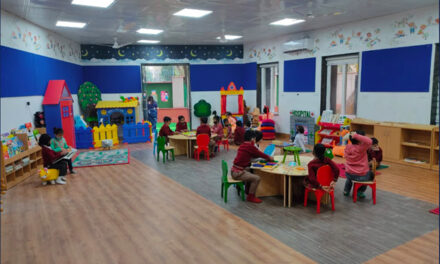This blog is written by Mary Burns, Education Development Center. It is part 1 of 2 blogs about the options teachers and educators have at their disposal to continue teaching online during the current widespread school closures. This blog was originally published on the Global Partnership for Education website on 9 April 2020.

Daniel is now in 5th grade and he attended a catch-up class. He has been supported through the Performance Lag Address Program (PLAP). PLAP is a catch-up learning program for grades 3 to 7. It was launched in 2012 in Zimbabwe. Catch-up classes help schools address challenges faced by students on the spot. GPE/Carine Durand
As I write this, UNESCO reports that 91% of the world’s students are out of school because of the coronavirus. While many education systems will use TV, radio or print to provide educational continuity to students, most places in the globe will turn to online learning.
This two-part post is designed for those who find themselves suddenly having to teach online (teachers, implementers, universities). This first post focuses on platforms and content. The next one will focus on instruction, assessment, preparing teachers and learners, and bandwidth.
These are not normal times and this is not your normal GPE post. Rather than big issues, this blog focuses on discrete software and applications. If you are planning to teach online, please look through the links. They are full of additional (mainly free) resources, tools and other practical information.
What is online education?
For the time being, online education is any teaching and learning you do online!
Online learning is not a monolith. Here I discuss three options for emergency online teaching.
Option 1: Online learning via a learning management system
This is what we think of as “traditional” online learning—classes that occur within a learning management system (LMS) or virtual learning environment (Moodle, Blackboard, Canvas). Learning management systems typically (but not always) organize learning by “modules” (units), have a shared calendar, assessment systems, gradebooks, libraries of content, content development capabilities, discussion boards, chat features, video conferencing capability, announcement, tracking and reporting features, and support third-party applications.
Advantages: LMSs are essentially virtual classrooms. There’s an instructor (or should be), classmates, a variety of content and activities, tests, and discussions. LMSs offer one-stop, centralized and secure learning (because learners need to be registered to take the course). All interaction with content, instruction and assessment typically occur within the LMS. LMSs typically support creation and hosting of a variety of content, so are good for high- and low-bandwidth environments. Learners can work asynchronously (not at the same time) or synchronously (at the same time), alone or as part of a cohort (class), do their assignments in a self-paced manner or on the same schedule as others.
Disadvantages:
- Cost: Yes, open-source platforms are often free but they can be complex or limited. These “Do It Yourself” systems demand personnel with design, maintenance, and technical skills and even additional equipment (like servers). In my experience, the best LMSs are commercial because they provide everything—technical support, hosting, content development, customization, integrated management systems and ease of use—but at a cost. Not all LMSs will be available in all languages—another reason why Moodle, the free and open source system with so many language packs, is so popular.
- Complexity: Even the simplest LMS can be complex. Learners have to be registered. Instructors and students have to learn how to navigate and work within an LMS. Getting used to the platform often creates a great deal of frustration on the part of users, so expect a learning curve.
- Platform: In my experience, LMSs are best for computers, not mobile phones. Taking an online course via a mobile phone increases “cognitive load”—it’s hard to read on a phone; scroll through a long thread of discussion posts; write long, thoughtful responses to a discussion prompt; and some features just don’t won’t work well on a phone or on the app version of the LMS.
Check out this review site for various learning management systems.
Option 2: Webinars or virtual classes
These are “web seminars” or “web meetings”—face-based, real-time interactions between teachers and learners. Most LMSs either have their own built-in web conferencing platform or support external web-conferencing platforms. Most webinar platforms support multimedia and video, have chats, polls, breakout rooms, and whiteboards. They often allow multiple presenters, screen sharing, and recording the webinar for later viewing.
The big differences are in the number of “seats” (students that can participate in the webinar at one time), features, support, cost; whether webinars can be recorded; the ability to create a persistent environment (so you don’t have to rebuild the layout each time you do a webinar); and whether or not platforms have integrated voice and audio (If not, you have to contract with an audio conferencing system).
Advantages: They’re visual. Teachers and learners interact in real time and can see each other. Webinars are great for one-to-many instruction, for sharing videos or PowerPoints, and for discussions. They can be recorded and hosted online (YouTube or in an LMS) so students can review them at a later time.
Disadvantages: Because they are video-based, webinars are bandwidth intensive. Further, they can be logistically complex to handle as you add more people and people from different time zones. Most, though not all, will need a host who acts as a gatekeeper, making sure participants are registered and can get into the webinar. Webinars often epitomize bad teaching—they are not planned or carefully organized; instruction is highly passive as the teacher just talks and listeners multitask or just check out. (There’s a lot more work to do on the pedagogy for webinars.)
For more information on choosing a webinar or web conferencing platform, read here, here and here.
Low cost/free platforms:
- BigBlueButton is an open source platform that is free but also has a paid version
- Open Broadcaster Software
- WebEx has a generous trial version, though the platform is not free
- Starleaf is reducing the cost of its platform during COVID19
- Zoom (free for 40 minutes)
- Webinar substitutes like Google Meet or Skype.
Option 3: Self-paced, do-it-yourself online learning
For a variety of reasons, many will have to forego options 1 or 2 and just “do it yourself” in terms of self-paced online learning for students. This third option can take several forms:
- Uploading curriculum resources and instructional materials (e.g. documents and teacher videos) on a portal or YouTube channel or emailing resources to students who complete these activities, either “doing” them online or submitting digital products to their teachers via email.
- Offline work with online delivery: This could involve asking students to complete their print-based textbook- and workbook-based activities on paper and either scanning or photographing the work and sending to a teacher; or using a word processor and emailing it to their teacher or completing it collaboratively with classmates via GoogleDocs.
- Self-paced learning with external education content: If there are no digital educational resources, teachers can develop playlists of external content (Khan Academy, educational YouTube videos, open content), choice boards (scavenger-hunt like) or hyper docs (a variation on a worksheet) that students work on alone, at their own pace. Or teachers can assign educational sites (PBS Learning Media) that students do as “enrichment” or extra-curricular work. If schools are able to afford them, students can continue with lessons via fee-based subscription education sites (IXL, Dreambox, NewsELA) or tutoring services (Paper Video). Depending on students’ ages, teachers can assign appropriate readings, book reports via online libraries, online books or open textbooks.
- Mix-and-match: Using social learning platforms, VoIP and messaging applications like FlipGrid, Skype, Voxer, for check-ins, sharing, instruction and online assessment with tools like GoFormative.
- Set up an online classroom: If your school does not have Google Classroom, this would be the time to sign up and get started. Google Classroom is free and allows teachers and students to seamlessly share documents and assignments. It also comes with a host of Google tools. Read more here.
To explore a list of online tools to create a “mix and match” of online learning options, go here.
Advantages: The greatest advantage of option 3 is that you do not have to learn how to use an LMS or webinar platform. This option may be more feasible than more bandwidth-intensive LMS and webinar platform and more feasible in terms of teacher workload. This is also a more flexible, lower-cost option than options 1 or 2.
Disadvantages: The greatest disadvantage is that it that it can make for haphazard instruction. Further, it strips learning of its social nature and leaves students on their own. Self-paced asynchronous learning is a recipe for high attrition, absenteeism and non-compliance. Do-it-yourself, self-paced, solo learning puts a lot of pressure on caregivers and parents to serve as the at-home teacher.
Content
Whatever option you decide upon, one thing is for sure in online learning: you will need content—basically, four types.





